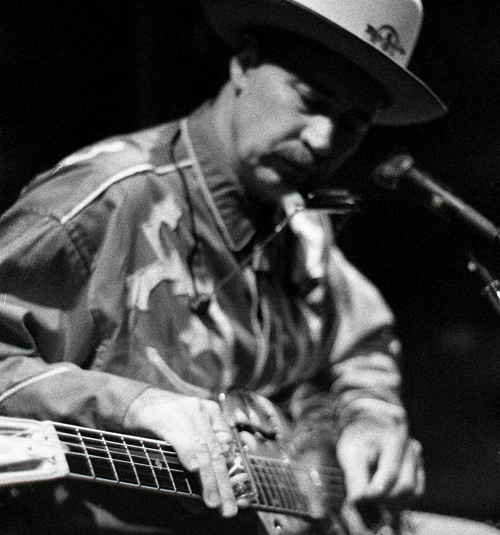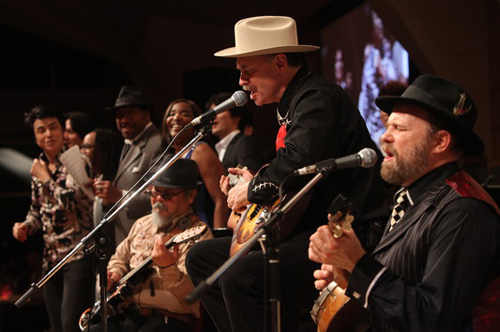Steve Gardner (part II) スティーブ・ガードナー (Part II)

|
How long have you been playing blues music in Japan? I’ve been playing almost since I landed in Japan back in late 1980. Karaoke was seeping into so many clubs that had once had live music. I found Tokyo to be a mass of bottle-keep places (where customers buy a bottle of whiskey and are allowed to store it there) with space for both guitars and “singing machines”, as we liked to call the big karaoke boxes that had tapes and mics attached. They came with a song book and there was often a “snack mama” (a proprietress of the bar or lounge), who would wave a wand in time with the music as the customers howled drunkenly to give each other the earache. In 1981 I played harmonica at one such small place in Ebisu. Beside the bottle-keep, the salary men who used to hang out there also liked to wear old western-style six-gun holster get ups with authentic-weight replica 44 revolvers. Most nights the club would have quick draw contests, live music and anything that you wanted to drink from the bar as long as it was whiskey and water, or beer. Not long after that I started travelling with CBS Sony recording artist Oki Toru and played on his tours every year from 1982-96. How has your music been received? After a great run as a professional photographer and musician, by 2000 I was ready to drop the photography and try to make a go at music full time. I received great support and encouragement from friends in Japan and at home so I just jumped off into the deep water and have been swimming for my life ever since. I enjoy Japan very much. I feel that Japan is very much like the American South where I grew up. The social system is vertical. Everyone is fairly guilt motivated in their actions: Have To vs. Want To. We use the same language to designate social hierarchy: ”Uncle”, “Aunt”, “Brother”, “Sister”. We never visit without bringing a gift and we are usually the most polite when we are mad at someone. Although Japan or Japanese are accused of “copying”, I feel that they have a great respect for the authentic and are anxious to learn. Both myself and my music have been well received by all ages just about everywhere that I have been in Japan. And being from Mississippi gives me a pretty good card to play in any game, especially since I have met or played with quite a few first and second generation blues men and women. It seems that blues music, as a genre, struggles in Japan. Why do you think that is? I feel that blues music, as a genre, struggles EVERYWHERE, not just in Japan. Although most admit that blues is the foundation of most modern music, we have almost no mainstream way of listening to it, celebrating it or even studying it. I bill myself as an American roots and blues player so that I might have the chance to break some of the stereotypes associated with the music, as well as create a chance to educate the listeners. I want to leave listeners wanting more and wanting to find out more. This is one of the reasons that I started my American Roots and Blues workshops. They are a very good chance to make learning fun for all ages! Who are some Japan-based expat and Japanese blues musicians you respect? I think that among blues harp players, “Weeping Harp” Senoh and Kotez are two of my favorites. My favorite blues bass man is Hisa Nakase with Yu “Jimanica” Ojima on drums. Guitar players: Kunio Kishida; Moony; Tadase Yanoo; Hightide Harris; Shinjiro Mori; Macoto Takahashi; ZODA. On mandolin, Taro Inoue and Bill Benfield. On Piano, Yancy. What have been some of your most memorable moments performing the blues in Japan? I have been touring off and on in Japan since 1983. I could tell you many crazy stories—times when none of the sound gear made it to the show and we ended up playing through emergency bull horns to a crowd of 1,500 in Akita on a cold, snowy night. Or the time that a club down in western Japan was taken over by large tattooed men with tightly permed hair all with fighting dogs on chains. Lucky for us they liked the blues. There was a night down in Kobe where we played for 380 Buddhist monks. The light was reflecting off everyone’s bald head so very strongly that it blinded us up on the makeshift stage and we stumbled around for three or four minutes just trying to find our spots. We played the old Hound Dog Taylor classic, “Give me back my wig”. After we translated the lyrics, everyone laughed and applauded. They loved it and ended up buying all of our CDs. But the most memorable show that I have ever done in Japan was on the night of March 11, 2011 after Japan was shaken by one of the worst quakes and tsunamis in recent history. I was up in Yamanashi, Kiyosato doing a workshop for Meiji University, along with several other instructors, 68 university students from Japan and a small group from York University, Canada. Because of the quake we lost all electrical power, water and heat as well as most phone service due to several towers being knocked down by the powerful quake. We had to sit tight, in the dark, the worst of course being there and not knowing anything. That night of March 11, everyone gathered around and I did a small show for the students by the light of cell phones and computers. I rewrote the Randy Newman tune “You’ve Got A Friend In Me” to fit the earthquake. Everyone sang along. The tune goes, “You’ve got a friend in me. You’ve got a friend in me. When the earth begins to shake and you think your heart may break, you’ve got a friend in me.” By the end of the night, which also included a magic show and some Irish music, we were all feeling better, ready to face the rest of the long night with a little more hope in our hearts and a prayer for those most affected on our lips. We made it, of course, but I shall not soon forget that night. Over the next year or so I had the chance to play special shows to raise money to help in the recovery efforts as well as to go up and play more than 41 shows from Fukushima to Ishinomaki. “…When your life seems so dark, I’ll be your spark. You’ve got a friend in me.” Where are some places people can enjoy the blues in Japan (festivals, venues, etc)? There is a string of smaller clubs up and down the JR Chuo line. Checker Board in Asagaya; Bright Brown in Nakano; Jirokichi in Koenji. In central Tokyo, Blue Heat in Yotsuya. Every 3rd Sunday, the Bashamichi Taproom in Yokohama features Blues for Blues night, where blues musicians perform and half the door charge goes to charity for supporting Tohoku. |
日本でブルースを演奏し始めたのはいつ頃? 1980年に来日して間もなく演奏を始めていました。多くの店が生演奏からカラオケに移行しつつあった時代です。ギターも置いているがカラオケもあり、ボトルキープができるような店舗が東京の至る所にありました。カラオケテープの音に合わせてマイクで歌う大型のカラオケボックスも人気でした。歌本が置いてあり、ママがいる店もたくさんありました。酔っ払いがわめき歌い、それに合わせてママが愛嬌を振りまきながら手拍子を打つ、といった感じでした。 1981年、私は恵比寿にあった小さな店でハーモニカをプレイしていました。サラリーマンたちが夜な夜な集い、キープのウイスキーを飲みながら腰にガンホルスターを着け、店内で金属製のモデルガンを振り回したりしていたんですよ。その店では毎晩のようにピストル早撃ち大会をやりながら、一方で生演奏もやり、ウイスキーやビールの飲み放題などもやっていました。やがて私はCBSソニーに所属していた大木トオルのバンドに入り、1982年から1996年までの毎年、彼のツアーに同行しました。 周りの反応は? 当時の私はフォト・ジャーナリスト兼ミュージシャンとして結構いい暮らしをしていたのですが、2000年頃にはフォト・ジャーナリストの仕事に疲れを感じ、音楽活動に専念することにしました。日本の友人やアメリカの友人たちからいろいろ助言やサポートもあったお陰で、思い切って音楽活動に専念することにし、今までやってこれました。 日本での生活はとても楽しくて、私が生まれ育ったアメリカ南部ととてもよく似たところがあると感じています。どちらも縦割り社会です。やりたい事とやらなければならない事の狭間で、誰もが何か行動を起こすときには半ば罪の意識に駆られて動いている感じも共通です。社会的身分を表す言い方も似ています。オジサン、オバサン、アニキ、アネキ、などの使い方です。知り合いを訪ねるときは必ず手土産持参で、誰かに腹を立てた時でさえ激しいケンカになったりしないのが普通です。日本はコピー大国だといわれますが、私が見るところ、日本人は本物に敬意を払い、そこから学ぶことに熱心なのです。私自身も私がプレイする音楽も、日本のどこでもあらゆる世代から歓迎されてきました。ミシシッピ出身だということもプラスに作用してきたと思いますし、多くの第一世代、第二世代のブルースマン、ブルースウーマンたちと出会い、共にプレイするようになってからはそう感じることが増えました。 ブルースという音楽ジャンルは日本ではなかなか大衆受けしないように思いますが、その理由は何だと思いますか? ブルースというジャンルは日本だけではなく、世界中どこでも大衆受けすることは無いように思います。ブルースが現代音楽の原点になっていると一般に言われている割には、ブルースを聞くにせよ、演奏するにせよ、学ぶにせよ、主流にはなかなかなり得ない。私はそうしたブルースに関する固定観念を打ち破るチャンスを模索するため、そしてリスナーを啓蒙するためにも、自分自身がアメリカのルーツミュージックとブルースのプレイヤーであることを誇りに思っています。リスナーがもっと聞きたいと感じ、もっとブルースを知りたいと思ってくれたら嬉しい。そんな気持ちもあって私はルーツミュージックやブルース、アメリカ南部の文化についていろいろな場でワークショップを開催するようになりました。私のワークショップはあらゆる世代が楽しく学べる素晴らしい内容だと自負しています。 日本在住の外国人ブルースマンや日本人のブルースマンで注目している人を挙げて頂けますか? ブルースハープ奏者では特に”Weeping Harp Senoh”こと妹尾隆一郎、Kotez(コテツ)、の二人は大のお気に入りです。ドラマーの”Jimanica”こと尾嶋優と組んで活動しているウッドベースの中瀬ヒサも素晴らしいですね。ギタリストでは岸田邦雄、Moonyこと表克美、矢野忠、ハイタイド・ハリス、森辰二郎、高橋誠、ローンウルフ造田。マンドリン奏者ではビル・ベンフィールド。ピアニストではYancy、といったところです。 日本での演奏活動の中で今まで印象に残っていることは? 1983年から不定期にツアーを続けてきましたが、その間クレージーな出来事がたくさんありました。雪の降る秋田で開演の時間になっても音響機材が会場に到着せず、1500人の聴衆の前で非常用の拡声器を使って演奏したこともありましたし、西日本のどこかのクラブイベントでは、パンチパーマに入れ墨、鎖につないだ闘犬を連れた強そうなお兄さんたちの集団に会場が占拠されました。彼らが我々の音楽を好意的に受け入れてくれたのでホッとしましたが。神戸では380人の僧侶の前で演奏しました。明るい照明が彼らの坊主頭に強烈に反射して光り輝き、仮設舞台に上がっていたバンドメンバーは目が眩んで、目が慣れるまでの数分間、自分の立ち位置が分からなかったほどでした。この時はハウンドドッグ・テイラーの代表曲”Give me back my wig”(オレのヅラを返せ)をやりました。歌の内容を日本語で紹介したところ、全員が爆笑し拍手してくれました。持って行ったCDが完売するほど皆さん楽しんで頂けました。 そんな数々のエピソードの中でも最も印象に残っているのは2011年3月11日のことです。この日は明治大学のワークショップの仕事で山梨県の清里というところに来ていました。他に数人の講師と68人の日本人大学生、カナダのヨーク大学からも何人か参加していました。地震発生後、電源が失われ、水も火も無く、電話もほとんど繋がらなくなりました。暗い中でじっとしているしか無く、周囲の状況も分からず最悪の状態でした。 その夜、私は集まっていた学生たちのために携帯電話とパソコンのわずかな明かりを頼りに小さな演奏会を行いました。ランディ・ニューマンの”You’ve Got A Friend In Me”の歌詞をアドリブでアレンジして歌い、皆が一緒になって歌ってくれました。「僕は君の友達。大地が揺れ、心が壊れそうになっても僕は君の友達だから」。 夜も更けてきた頃、手品を楽しんだりアイリッシュ音楽も何曲かやったりして皆少し落ち着きを取り戻してきました。希望を捨てず、大きな被害を受けた人たちのために祈りを捧げながら一夜を明かす覚悟が出来てきました。そうして皆で励まし合いながらその夜は過ごしたのですが、あの夜のことはいつまでも忘れることは無いでしょう。 その後、募金のためのライブをやる機会も何度かあり、福島や石巻など現地でも41回以上演奏し、歌ってきました。「君が希望を見失いそうになった時は僕が君の希望になろう。僕はずっと君の友達だから」。 日本でブルースを楽しむのにお勧めのお店を教えてください。 JR中央線沿いには小さいながら魅力的なお店が何軒かあります。阿佐ヶ谷のChecker Board、中野のBright Brown、高円寺のJirokichi、などです。都心では四谷のBlue Heatがお勧め。横浜の馬車道タップルームでは毎月第3日曜日にBlues for Bluesというライブイベントを開催していて、入場料の半分が東北支援のためのチャリティーに寄付されます。 |









